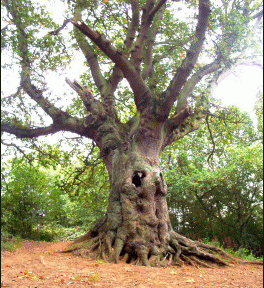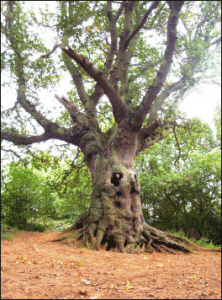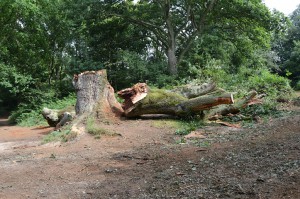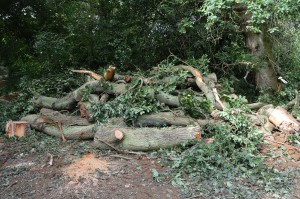
I have received some sad news this week for the Oxford locality. On Monday 13th July, a very impressive and iconic Oxfordshire oak tree has come down. The Shotover Oak was the oldest Pedunculate Oak (Quercus robur) in the Shotover Country Park. It began as an acorn in Tudor times, and germinated late in the reign of Queen Elizabeth I; in fact not long after she travelled over Shotover in 1566. At least twice in its long life this tree has had its upper canopy harvested for small timber and pollarding generally prolongs the life of a tree. In 2014 it had a girth of 5.3 metres and a healthy canopy of about 16 metres in diameter. A dendrochronological core taken in 2010 showed it to be growing quite vigorously for its age, with a new growth ring of more than a millimetre still being added each year. The tree was estimated to be between 410 and 450 years old.
The cause of the collapse of this cherished tree is a combination of hollowing of the main lower branches and the dry conditions. It seems strange that a tree can survive a gale and yet not a drought but in dry summer conditions trees are more brittle and heavy with leaves. The self-pruning or ‘summer branch drop’ is a well-known phenomenon in Oaks but is seldom as catastrophic as seen here.
The Oxford City Council Parks team have ensured that the boughs and branches are laid safely on the ground, and stacked in piles for the benefit of wildlife. The fallen wood has been placed nearby for two important reasons: firstly to allow the disturbed wildlife to relocate itself (mammals, birds, insects and mosses and lichens) and secondly for the continuity of dead wood habitat. Through the recent insect work by the voluntary group Shotover Wildlife, the Country Park is now recognised for the rare beetles and flies that depend upon dead wood and the big hollow boughs have been left close to where they fell for these insects to re-adjust to the new circumstances.
The Shotover Oak now enters a new stage of life – as prime habitat for the insects and fungi that dwell and feed in the labyrinth of timber and rotting wood that is so important for these species. Although it is a sad sight to see the tree decimated in this way, the trunk stump itself will continue to be an asset to wildlife, if left undisturbed, to continue its natural processes. Some small new buds and associated leaves have been spotted on one side of the tree at the very base of the trunk so fingers crossed, some regeneration will occur.
To find out more about the natural history of this great country park and SSSI, please visit the Shotover Wildlife website. To find out more about ancient trees, visit ATF.



